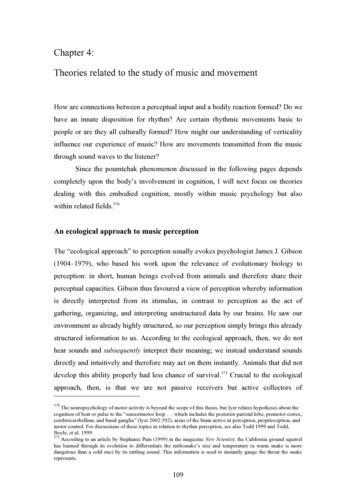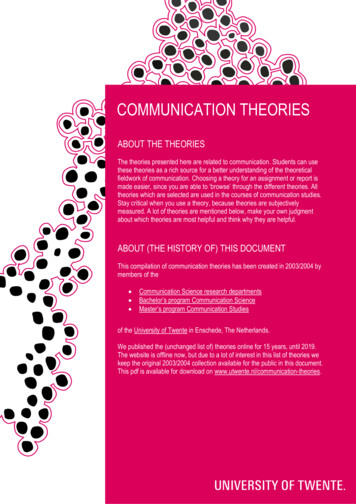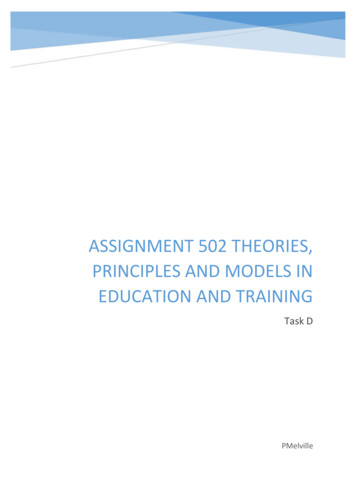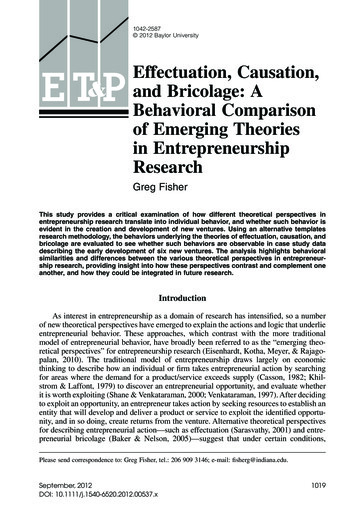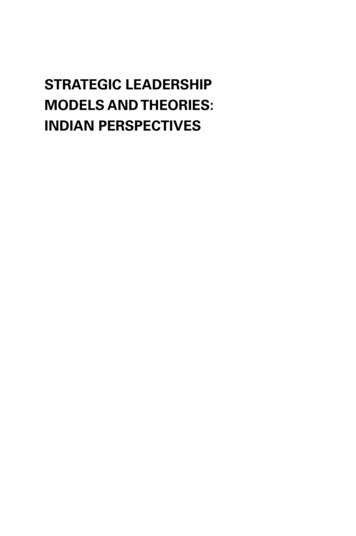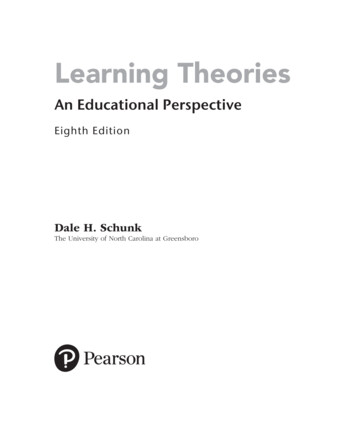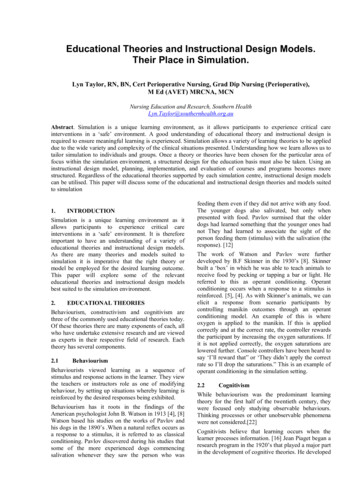
Transcription
LEARNING THEORIES - BEHAVIORISMCHAPTERlCHAPTER 44Learning Theories- BehaviorismLE ARNI NG OUTCOMESAfter studying this chapter, you should be able to:1.Explain the principles of classical conditioning, operant conditioning and sociallearning theory;2.Compare among classicallearning theory; and3.Apply the principles of classical conditioning, operant conditioning and sociallearning theory in classroom al
CHAPTER 4lLEARNING THEORIES - BEHAVIORISMINTRODUCTIONLearning is the main focus in thefield of educational psychology. InChapter 1, we have briefly explained themeaning of learning from three majorperspectives including the behaviouralperspective. In this chapter, we shallextend the discussion of behaviouralapproaches to learning in greater detail.We begin by discussing the classicalconditioning. Next, we examine thedefinition and concepts of operantconditioning. This is followed by theexplanation of the principles in the social learning theory. In the final section of thischapter, we look at the application of the principles of classical conditioning, operantconditioning, and social learning theory.4.1Classical ConditioningThe concept of classical conditioning was developed by a Russian physiologist, IvanPavlov (1849-1936). According to Papalia, Feldman, & Olds, they define the classicalconditioning as:From the definition above, we understand that the key element in classical conditioning isassociation. It means that if two stimuli repeatedly experienced together, they will becomeassociated. For example, if a student frequently encounters unpleasant stimuli inMathematics class such as unfriendly teachers, difficult questions, and a lot of homework,he may learn to dislike Mathematics.85i.85
LEARNING THEORIES - BEHAVIORISM4.1.1lCHAPTER 4Pavlov’s ExperimentsIvan Pavlov,Russian physiologistPavlov discovered classical conditioning almost by accident.Originally, he wanted to study the role of salivation in digestion. Hemeasured how much saliva dogs produce when given meat. Aftera few days in the experiment,Pavlov noticed that the dogs in hislaboratory started salivating when the lab attendant entered theroom with the meat dish, before meat was placed in their mouth.This aroused Pavlov’s curiosity and he pursued theissue with more experiments. For example, he sounded a bell just beforepresenting his dogs with food. After hearing the bell many times right beforegetting fed, the dogs began to salivate as soon as the bell rang. In other word, the dogshad been conditioned to salivate in response to a new stimulus (the bell) that normallywould not produce salivation. The dogs had learned to associate the bell with food.4.1.2Types of Stimulus and ResponseRemember from Chapter 1 that a stimulus is an observable environmental event that has apotential to exert control over a behavioural response. A response is an over behaviour by alearner. Put it in a simpler way, a stimulus is anything that can directly influence behaviourand the stimulus produces a response.In classical conditioning, there are 2 types of stimulus and 2 types of response. They areunconditioned stimulus, conditioned stimulus, unconditioned response, and conditionedresponse as explained in figure 4.1.Classical ConditioningStimulusResponseUnconditioned stimulus (UCS)Unconditioned response (UCR) This is a stimulus that can produce theresponse without any learning. Example: Meat. This is the unlearned or inborn reactionto the unconditioned stimulus. Example: Salivation.Conditioned stimulus (CS)Conditioned response (CR) Conditioned stimulus acquired theability to produce the response becauseit was paired (associated) with theunconditioned stimulus. Example: Bell. When a response is produced by theconditioned stimulus, it is referred to asthe conditioned response. Example: Salivation.Figure 4.1: Types of stimulus and respons in classical conditioning86
CHAPTER 4lLEARNING THEORIES - BEHAVIORISMLook at Figure 4.2 to help us understand the meaning of these stimulus and responses aswell as the steps in the process of classical conditioning.i.8787
LEARNING THEORIES - BEHAVIORISMlCHAPTER 4Figure 4.2: Process of classical conditioning4.1.3Common Phenomena in Classical ConditioningThere are 3 common phenomena in classical conditioning, they are generalization, discrimination, and extinction. The descriptions for these phenomena are explained below.GeneralizationGeneralization occurs when similar stimuli to a CS produce the CR. Astudent may generalize his fear to physics and chemistry tests althoughhe had performed poorly only on mathematics test. In this case, thephysics and chemistry tests were similar stimuli to the mathematicstest and they produced the CR by themselves.DiscriminationDiscrimination is the opposite of generalization. It refers to the ability to differentiate between similar stimuli. For example, a student mayfeel fear during mathematics test but not during physics or chemistrytests. This shows that the student is able to discriminate betweenappropriate and in appropriate situations for a response.ExtinctionExtinction is the process of unlearning a learned response because ofthe removal of the original source of learning. In classical conditioning,extinction is done by repeatedly presenting the CS without the US. Thisaction will decrease the frequency of previously CR. Eventually, the CRdisappears. In the example mentioned above, if the student repeatedlypasses the mathematics tests, his fear of mathematics tests will disappear.1. List three examples of learning from the behavioral perspective.2. Describe some examples of classical conditioning from yourexperience.3. Think of ways in which classical conditioning is used by advertisers.88
CHAPTER 44.2lLEARNING THEORIES - BEHAVIORISMOperant ConditioningOperant or instrumental conditioning is a form of learning in which the consequences ofbehaviour lead to changes in the probability that the behaviour will occur. Thondike (18741949) was the pioneer in studying this kind of learning. His famous formulation of Law ofEffect lies at the heart of the operant conditioning. The Law of Effect states that:“Behavior that brings about a satisfying effect (reinforcement) is apt tobe performed again, whereas behavior that brings about negative effect(punishment) is apt to be suppressed.”(Morris & Maisto, 2001)4.2.1Types of Reinforcement and PunishmentReinforcement is a consequence that increases the probability that a behaviour will occur. Onthe other hand, punishment is a consequence that decreases the probability a behaviour willoccur. Put it another way, reinforcement will strengthen a behaviour while punishment willweaken a behaviour. There are 2 forms of reinforcement and punishment as shown in figure4.3.Figure 4.3: 2 types of reinforcement and punishmentTake note that when something is added or presented, the process of learning is calledpositive and when something is removed or taken away, the process of learning is callednegative. Table 4.1 helps us to understand these forms of reinforcement and punishment.89i.89
LEARNING THEORIES - BEHAVIORISMlCHAPTER 4Table 4.1: Forms of Reinforcement and Punishment4.2.2Schedule of ReinforcementReinforces are more effective when they are given as soon aspossible after a student performs the target behaviour. In continuous reinforcement like this, a student learns very rapidlybut when the reinforcement stops, the behaviour decreasesrapidly too. Therefore, the schedule of reinforcement wasdeveloped. The schedule will determine when a behaviourwill be reinforced. There are 4 types of schedule of reinforcement, they are fixed-ratio schedule, variable-ratio schedulefixed, fixed-interval schedule, and variable-internal schedule. Look at Figure 4.4 to understand the meaning of theseschedules.Fixed-ratioschedule A behavior is reinforced after a set number of responses have occurred. For example: A student may be given a bar of Kit Kat chocolate forevery ten mathematical problems solved.90
CHAPTER 4lLEARNING THEORIES - BEHAVIORISM On a variable-ratio schedule, the number of responses needed to gainthe reinforcement is not constant.Variable-ratioschedule fixed For example: Rewards could be given after 3, 5, 9, and 15 mathematicalproblems solved. On a fixed-ratio schedule, a behavior is reinforced after a set numberof responses have occurred. For example: A student may be given a bar of Kit Kat chocolate forevery ten mathematical problems solved.Fixed-intervalschedule A behavior will be reinforced after a certain period of time. Nomatter how often it occurs, the behavior will not be reinforced untilthe time is up. For example: Students are given a quiz every Wednesday.Variable-internal Also based on time passing but the time period keep changing.schedule For example: Students are given pop quizzes.Figure 4.4: Schedule of reinforcement4.2.3Dangers of PunishmentPunishment presents the fastest way tochanging behaviour. However, punishment might be dangerous to an individual.Among of the effect of punishments are: Punishment can be abusive.- For example, a teacher might becomeso aroused when he is punishing astudent that he becomes abusive.Punishment may create a new problem,that is aggression.- Students commonly react to physical punishment by learning to dislike the punisherand perhaps by reacting aggressively toward that person.Thus, punishment does not convey any information about what an alternative and moreappropriate behaviour might be. It may suppress one inappropriate behaviour only to bereplaced by another one. Punishment can turn out to be reinforcing. A student might learnthat misbehaving will get the teacher’s attention.91i.91
LEARNING THEORIES - BEHAVIORISMlCHAPTER 4As a conclusion, punishment should be used only as the last option. Do not use positivephysical punishment. Use negative punishment, instead. A teacher should first positivelyreinforced appropriate behaviours to take place of the inappropriate behaviours he is tryingto eliminate.1. Explain the types of reinforcement and punishment.2. List some similarities and differences between classical and operantconditioning.4.3Social Learning TheorySocial learning theory extends behaviourism. Both behaviourism and social learningtheory agree that experience is an important cause of learning. They also include the conceptsof reinforcement and punishment in their explanation of behaviour. Furthermore, theyagree that feedback is important in promoting learning (Eggen and Kaucak, 2007).4.3.1Observational LearningMost of the principles of the social learning theory were developed by Bandura(Papalia, Olds & Feldman, 2007). Social learning theory believes that students learn byobserving or watching and imitating other people. This process is called modelling orobservational learning.According to Hinrichs,“Observational learning is so common and so powerful”Hinrichs, 2004One of the most important examples is the effect of watching violent media has onaggressive behaviour as shown in Figure 4.5.92
CHAPTER 4lLEARNING THEORIES - BEHAVIORISMFigure 4.5: Among of the effects of watching violent media.The newer version of social learning theory is called the social cognitive theory. The changeis due to a greater emphasis on cognitive processes in learning.According to Bandura;i.“Both social and cognitive factors play important roles in learning.”Bandura (1989)There are 4 processes involved in observational learning. These include attention, retention,production, and motivation as explained in figure 4.6.Process 1- AttentionBefore students can imitate a model’s behavior, they must pay attention to what the modelis doing or saying. For example, seeing a teacher writing from the same perspective asthe student see their own makes observational learning easier.Process 2- RetentionTo produce a model’s action, students must be able to store the model’s action in theirmemory for future retrieval. Students’ retention will be improved when a teacher givesvivid, logical, and clear demonstrations.Process 3- ProductionTo attending and remembering, students must be physically capable of reproducing themodel’s action. Here, the students need a lot of practice, feedback, and coaching beforethey can reproduce the model’s action.9393
LEARNING THEORIES - BEHAVIORISMlCHAPTER 4Process 4 - MotivationThe students must be motivated to demonstrate the model’s action. Reinforcement can beuse to encourage observational learning. For example, a teacher can use direct reinforcementsuch as saying “Good work!” Alternatively, a teacher may want to use vicarious reinforcement.In this case, a student may simply see other students being reinforced for a particularbehavior and then he increases his own production of that behavior.Figure 4.6: 4 processes involved in observational learning4.3.2Reciprocal Determination ModelBandura developed a reciprocal determination model that comprises 3 factors. The factorsare behaviour, person, and environment as shown on Figure 4.7.Figure 4.7 Interactions of 3 factors in reciprocal determination modelBehaviour, environment and person factors interact to influence learning. They influenceand are influenced by each other. For example, a teacher’s feedback(environment) canlead students to set higher goals(person/cognitive) and these goals will motivate studentsto put more efforts (behaviour) in their studies.1. How would observational learning be useful to you as a teacher?2. What are some contributions and criticism of the social learningtheory?94
CHAPTER 44.4lLEARNING THEORIES - BEHAVIORISMBehaviourism in the ClassroomThis section describes how teachers can apply the principles of behaviourism in theclassroom. It is divided into three subsections according to the perspectives discussedearlier that are classical conditioning, operant conditioning and social learning theory.4.4.1Applying Classical Conditioning in the ClassroomThe key element
4.2 OPERANT CONdITIONING Operant or instrumental conditioning is a form of learning in which the consequences of behaviour lead to changes in the probability that the behaviour will occur. Thondike (1874-1949) was the pioneer in studying this kind of learning. His famous formulation of Law of Effect lies at the heart of the operant conditioning .
